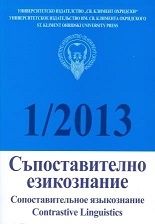Lectura desde la teoría vectorial de Guillermo Rojo de las formas con marcador „ще да“ en el sistema verbal búlgaro. Encuentros y desencuentros con...
Applying of Guillermo Rojo’s vector theory to the forms with marker „ще да“ in the Bulgarian verbal system. Similarities and contrasts to Spanish verb
Author(s): Tania LalevaSubject(s): Language and Literature Studies
Published by: Софийски университет »Св. Климент Охридски«
Summary/Abstract: In the paper the group of verb forms with the common formal marker “ще (да)” [shte da] is analyzed and it is contended that time is the basic structuring element in the Bulgarian temporal verbal system. The temporal and extra-temporal meanings of verbs from the group are analyzed by applying Guillermo Rojo’s vector theory and his ideas on dislocation in the system of the Spanish verb. Bulgarian and Spanish forms with dislocation of the type ‘+V’ > ‘oV’ are compared. It is claimed that this type of dislocation attributes an extra-temporal meaning of probability to these verbs. The conclusion is drawn that dislocation in Bulgarian functions at the level of the system in the plane of the present and is developed as a morphological model in the plane of the past. The similarities and contrasts between the two languages are also analyzed.
Journal: Съпоставително езикознание / Сопоставительное языкознание
- Issue Year: 2013
- Issue No: 1
- Page Range: 66-77
- Page Count: 12
- Language: Spanish
- Content File-PDF

